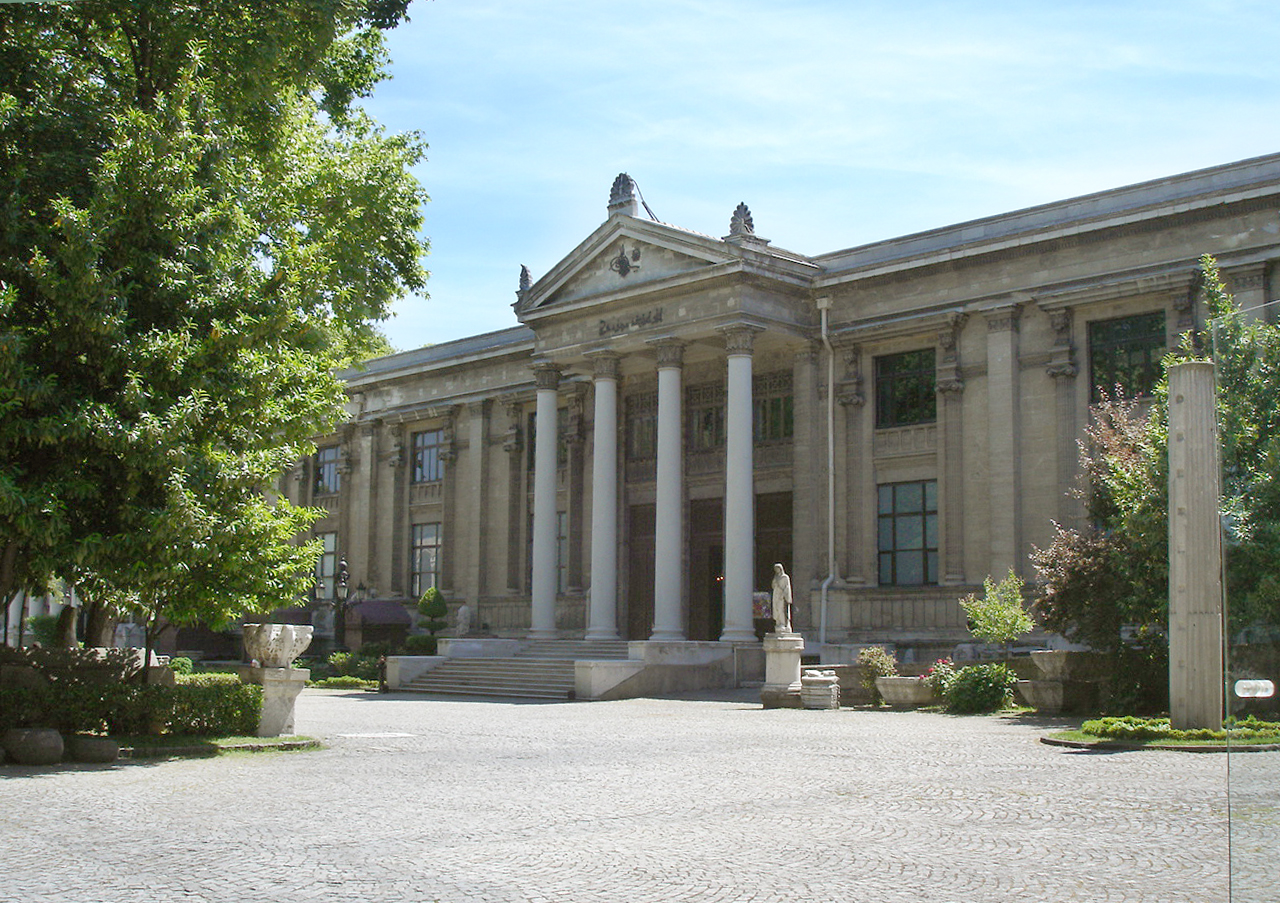- Istanbul Archaeology Museums
Infobox museum
name = Istanbul Archaeology Museums
imagesize = 250
established =13 June 1891
collection = 1+ million objects
location = Osman Hamdi Bey Yokuşu Sokak, Gülhane,Istanbul ,Turkey
type = Archaeology museum
visitors = 200,000 [cite web|url=http://sanat.milliyet.com.tr/detay.asp?id=3219|title="Eser zengini-ilgi fakiri müzeler."|date=2007-02-28|accessdate=2008-04-02|author=Milliyet Newspaper Online|language=Turkish]
director = İsmail Karamut
website = [http://www.kultur.gov.tr/EN/BelgeGoster.aspx?17A16AE30572D313679A66406202CCB01966176E3ABFFFF2 Ministry of Culture and Tourism] The Istanbul Archaeology Museums ( _tr. İstanbul Arkeoloji Müzesi) is an archeological museum, located in theEminönü district ofIstanbul ,Turkey , nearGülhane Park andTopkapı Palace .The Istanbul Archaeology Museum consists of three museums.
#Archaeological Museum (main building),
#Museum of the Ancient Orient and the
#Museum of Islamic Art (Tiled Kiosk).It houses over one million objects that represent almost all of the eras and civilizations in world history.
History
The site of the museums actually belonged to the
Topkapı Palace outer gardens. The museum was founded by decree as the Imperial Museum ("İmparatorluk Müzesi"). When it opened to the public in1891 , it was the first one to feature Turkish art. The firstcurator wasOsman Hamdi Bey , who was also the founder of the museum. Since the imperial decree protecting cultural goods in the Ottoman empire was enforced, many governors from the different provinces would send in found artefacts to the capital city. In that way the museum was able to amass a great collection. Upon its 100th anniversary in 1991, the Museum received theEuropean Council Museum Award, particularly for the renovations made to the lower floor halls in the main building and the new displays in the other buildings.The construction of the main building was started by Osman Hamdi Bey in 1881, attaining its present neo-Greek form in 1908. The architect was
Alexander Vallaury . The façade of the building was inspired by theAlexander Sarcophagus and Sarcophagus of the Mourning Women, both housed inside the Museum. It is one of the prominent structures built in the neoclassical style in Istanbul.The Museum of the Ancient Orient was commissioned by Osman Hamdi Bey in 1883 as a Fine Arts School. Then it was re-organised as a museum and opened in 1935. It was closed to visitors in 1963, and reopened in 1974 after restoration works on the interior.
The
Tiled Kiosk was commissioned by SultanMehmed II in 1472. It is one of the oldest structures in Istanbul featuring Ottoman civil architecture and was a part of the Topkapı Palace outer gardens. It was used as the Imperial Museum between 1875 and 1891 before the collection moved to the newly constructed main building. It was opened to public in 1953 as a museum of Turkish and Islamic art, and was later incorporated into the Istanbul Archaeology Museum.Collection
The ornate
Alexander Sarcophagus , once believed to be prepared forAlexander the Great , is among the most famous pieces of ancient art in the museum. [ [http://travel.nytimes.com/travel/guides/europe/turkey/istanbul/attraction-detail.html?vid=1154654614207 The New York Times - Istanbul Archaeology Museum] ] The "Kadesh Peace Treaty" (1258BCE ), signed betweenRamesses II of Egypt andHattusili III of the Hittite Empire, is another favourite of the visitors. It is the oldest known peace treaty in the world, and a giant poster of this tablet (treaty) is on the wall of theUnited Nations Headquarters inNew York City .The museum has a large collection of
Turkish , Hellenistic and Roman artifacts. The most prominent artifacts exhibited in the museum include:* Alexander Sarcophagus, found in the necropolis of
Sidon .
* Sarcophagus of the Crying Women, also found inSidon .
* Sarcophagi of Tabnit and theSatrap .
* TheLycia n tomb, a monumental tomb.
* Glazed tile images from theIshtar Gate of Babylon.
* Statues from ancient times until the end of the Roman era, fromAphrodisias ,Ephesus andMiletus .
* Statue of anEphebos .
* Parts of statues from the Temple of Zeus found at Bergama.
* Statue of a lion, the only piece saved from the hands of British archaeologists in theMausoleum of Maussollos .
* Snake's head from theSerpentine Column erected in the Hippodrome.
* Mother-GoddessCybele and votive stelai.
* Busts ofAlexander the Great andZeus .
* Fragments from the temple ofAthena atAssos .
* TheTroy exhibit.
* 800.000 Ottoman coins, seals, decorations and medals.
* One of the three known tablets of the Treaty of Kadesh.
* The obelisk of theAssyria n kingAdad-nirari III .
* Tablet archive containing some 75.000 documents withcuneiform inscriptions.
* Artifacts from the early civilizations ofAnatolia ,Mesopotamia ,Arabia andEgypt .
*Siloam inscription , which made the headlines in July 2007 [cite web | url= http://news.yahoo.com/s/ap/20070713/ap_on_re_mi_ea/israel_ancient_tablet Article:| title = Jerusalem seeks return of ancient tablet|authors=Matti Friedman|publisher=Yahoo News | accessdate=2007-07-13|language=English ]ee also
*
Istanbul Mosaic Museum
*Turkish and Islamic Arts Museum
*Museum of Anatolian Civilizations References
External links
* [http://www.pointsfromturkey.com/Istanbul_Archaeological_Museum.html Points from Turkey - Istanbul Archaeological Museum ]
* [http://www.kultur.gov.tr/EN/BelgeGoster.aspx?17A16AE30572D313679A66406202CCB01966176E3ABFFFF2 Museum's official website]
* [http://www.archmuseum.org/biyografi.asp?id=10073 Museum of Architecture - Istanbul Archaeology Museum]
* [http://www.pbase.com/dosseman/archaeological_museum_istanbul Very many pictures from the museum by a private photographer]
Wikimedia Foundation. 2010.
